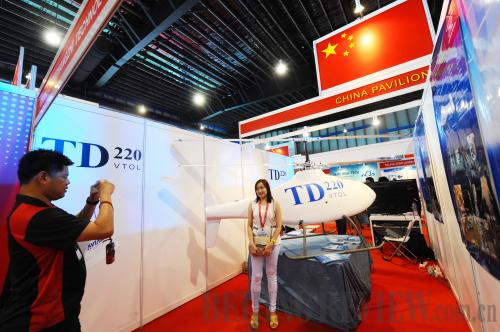|
 |
|
SMILE FOR CHINA: People taking snapshots at the 2014 Singapore Airshow' s China pavilion on February 12 (DENG ZHIWEI) |
Robust Trade
Stronger-than-expected growth in China's foreign trade in January has surprised the market.
China's foreign trade volume climbed 10.3 percent year on year in January to $382.4 billion, marking a strong beginning for 2014, according to data released by the General Administration of Customs on February 12.
Exports rose 10.6 percent from a year earlier to $207.13 billion, while imports increased 10 percent to $175.27 billion. The trade surplus stood at $31.86 billion in January, up 14 percent from a year ago and 24.25 percent from December 2013.
Chang Jian, Chief China Economist at Barclays Capital, called the January figures "surprisingly strong," as the institution expected weak January trade performance based on weak PMI export orders, a high base from last year, and holiday distortions.
"Today's strong export report could have been boosted by a rush of shipments ahead of the Chinese New Year holiday," Chang said.
Overall, the data suggest that the underlying strength of Chinese exports is probably better than we expected, he added.
Electric Car Subsidies
On February 8, the Chinese Government announced measures to further promote the use of new-energy vehicles in an effort to save energy and cut emissions.
Subsidies for new-energy car buyers in 2014 and 2015 will be raised from previous levels regulated by a standard introduced in September 2013, according to a statement jointly issued by the Ministry of Finance and three other government departments.
New-energy passenger car buyers received subsidies from 35,000 yuan ($5,730) to 60,000 yuan ($9.894) per vehicle in 2013, while new-energy coach buyers received subsidies of up to 500,000 yuan ($82,450) in 2013.
In 2013, it was stipulated that China would lower the subsidies by 10 percent this year from the 2013 level and by 20 percent in 2015.
The new statement, however, made an adjustment that will lower subsidies by only 5 percent in 2014 and 10 percent in 2015 from the 2013 level. The change came into effect on January 1, 2014.
To enhance government support for new-energy vehicles, the subsidy policy, which was scheduled to be phased out at the end of 2015, will be extended, the statement said.
Aviation Biofuel
China's top oil refiner has been given a license allowing the commercial use of its self-developed aviation biofuel, the country's aviation authority said on February 12.
The Civil Aviation Administration of China (CAAC) granted the license, the first of its kind, to Sinopec, allowing the company's No.1 Aviation Biofuel to be used by airlines.
Xu Chaoqun, Deputy Director of CAAC's Flight Criteria Department, hailed the development as a significant breakthrough for the country's research, production and application of aviation biofuel.
CAAC received Sinopec's application for commercial use of the biofuel in early 2012. The No.1 Aviation Biofuel had gone through several rounds of strict tests before it was given the green light, according to Xu.
With an annual consumption of nearly 20 million tons, China has become a large consumer of aviation fuels, and the development of biofuel will help ease resource pressures and cut pollution.
Biofuel is gaining popularity worldwide. The International Air Transport Association forecasts that biofuel will account for 30 percent of aviation fuel used by 2020.
| 